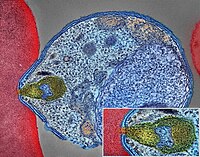
Photo from wikipedia
BackgroundIn malaria endemic populations, complex patterns of Plasmodium vivax and Plasmodium falciparum blood-stage infection dynamics may be observed. Genotyping samples from longitudinal cohort studies for merozoite surface protein (msp) variants… Click to show full abstract
BackgroundIn malaria endemic populations, complex patterns of Plasmodium vivax and Plasmodium falciparum blood-stage infection dynamics may be observed. Genotyping samples from longitudinal cohort studies for merozoite surface protein (msp) variants increases the information available in the data, allowing multiple infecting parasite clones in a single individual to be identified. msp genotyped samples from two longitudinal cohorts in Papua New Guinea (PNG) and Thailand were analysed using a statistical model where the times of acquisition and clearance of each clone in every individual were estimated using a process of data augmentation.ResultsFor the populations analysed, the duration of blood-stage P. falciparum infection was estimated as 36 (95% Credible Interval (CrI): 29, 44) days in PNG, and 135 (95% CrI 94, 191) days in Thailand. Experiments on simulated data indicated that it was not possible to accurately estimate the duration of blood-stage P. vivax infections due to the lack of identifiability between a single blood-stage infection and multiple, sequential blood-stage infections caused by relapses. Despite this limitation, the method and data point towards short duration of blood-stage P. vivax infection with a lower bound of 24 days in PNG, and 29 days in Thailand. On an individual level, P. vivax recurrences cannot be definitively classified into re-infections, recrudescences or relapses, but a probabilistic relapse phenotype can be assigned to each P. vivax sample, allowing investigation of the association between epidemiological covariates and the incidence of relapses.ConclusionThe statistical model developed here provides a useful new tool for in-depth analysis of malaria data from longitudinal cohort studies, and future application to data sets with multi-locus genotyping will allow more detailed investigation of infection dynamics.
Journal Title: Malaria Journal
Year Published: 2018
Link to full text (if available)
Share on Social Media: Sign Up to like & get
recommendations!